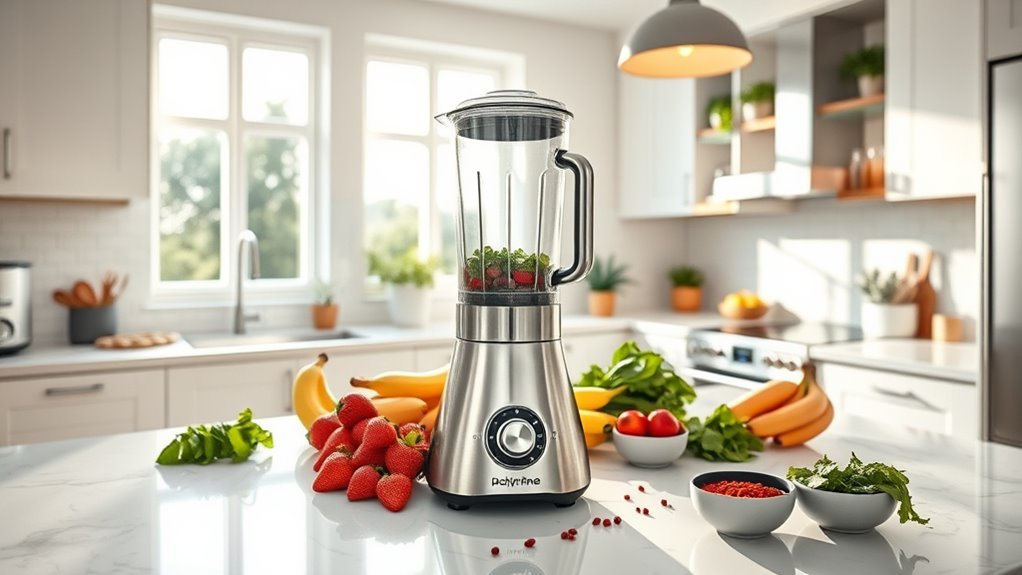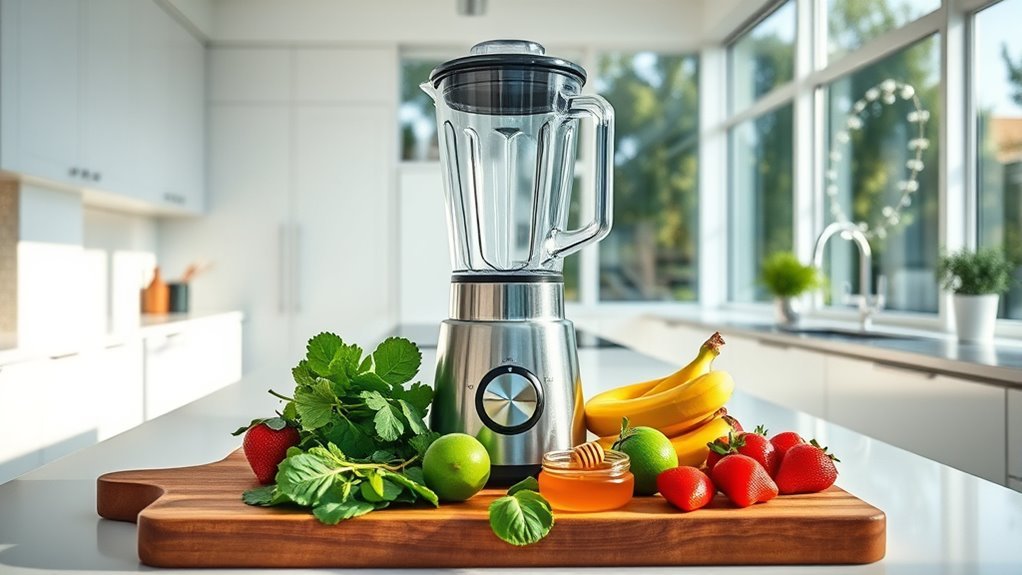We’ll make this simple: For commercial blenders, match motor power to your daily volume. Light duty needs 0.75 HP (560 watts), while heavy-duty operations demand up to 3.75 HP (2800 watts). Serving over 75 drinks daily? Go for 3.5 HP minimum. Remember, 1 HP equals 746 watts – higher wattage means faster blending and better handling of tough ingredients. The right motor choice prevents operational bottlenecks and keeps your kitchen humming along. Let’s power up your decision-making.
Understanding Motor Power Ratings and Performance Metrics

A proper grasp of motor power ratings is vital for selecting commercial blenders that won’t fail under pressure.
We’re looking at two critical numbers here: peak horsepower, ranging from 1 HP to 3.75 HP, and continuous power measured in watts. These metrics tell us exactly what your blender can handle.
Let’s get real about performance metrics in high-performance blenders. Motors spinning at 100,000 RPM will pulverize anything you throw at them, while torque ratings like 6.139 N·m guarantee smooth operation under heavy loads. High-performance blenders are designed to handle both wet and dry ingredients with ease, making them ideal for commercial use.
We’re not just talking raw power – it’s about sustained performance. When you’re blending commercial volumes, you’ll need both the peak power for crushing ice and the continuous output for maintaining consistency through long shifts.
Key Factors Affecting Blender Motor Selection
While choosing the right commercial blender might seem straightforward, the motor selection process demands careful analysis of several critical factors.
We’ve found that high-performance blender selection boils down to understanding your specific needs and operational demands.
- Daily Usage Volume – For businesses blending over 75 drinks daily, we recommend motors of 3.5 HP or higher to maintain consistent high-speed performance.
- Power Requirements – Look for blenders featuring 1800-watt motors when you need commercial-grade capability, especially for crushing ice and tough ingredients.
- Noise Considerations – Modern blenders feature QuietBlend™ technology, delivering powerful performance without disrupting customer experience.
Remember: torque output matters as much as horsepower. A Direct Drive motor with 6.139 N.m torque guarantees smooth blending of thick mixtures, making it essential for versatile commercial applications. Additionally, investing in a high-performance blender can enhance cooking efficiency and streamline your kitchen operations, ensuring you meet customer demands effectively.
Power Requirements for Different Blending Applications

Understanding the power requirements for specific blending applications separates successful commercial operations from struggling ones.
We’ll get straight to the numbers: light-duty operations need at least 0.75 HP (560 watts), while heavy-duty tasks demand up to 3.75 HP (2800 watts).
For high-volume environments serving 75+ drinks daily, we’re looking at 3.5 HP motors like the Waring Commercial Xtreme.
If you’re pushing 150+ daily blends, consider the Connoisseur’s 1800-watt powerhouse.
Here’s the kicker – motor power directly impacts blending speed and efficiency. Higher wattage means faster blending and better handling of tough ingredients like ice and frozen fruit.
Don’t skimp here – match your motor to your volume needs, or you’ll bottleneck your entire operation.
Comparing Horsepower vs. Wattage in Commercial Units
Since commercial blender specs come in both horsepower and wattage, you’ll need to master the conversion: 1 HP equals 746 watts.
When we’re comparing units, here’s what matters for real-world performance:
- A 3 HP commercial blender delivers 2238 watts of crushing power – perfect for frozen drinks and tough ingredients that’d kill your home unit.
- Most professional-grade blenders operate between 2.4 HP (1796 watts) and 3.75 HP (2794 watts), giving you the muscle for high-volume operations.
- Don’t get fooled by wattage alone – it’s just power consumption, while horsepower tells us actual blending capability.
We’ve found that matching your power needs to daily usage is essential.
A smoothie shop needs that 3+ HP beast, while a small café might cruise fine with 2.4 HP.
Heat Management and Motor Durability Considerations

Because powerful commercial blender motors generate serious heat under load, you’ll need proper thermal management to prevent early burnout. We’ve found that brushless motors, like Blendtec’s Titan X, deliver superior heat management while tripling motor durability.
| Feature | Impact on Performance |
|---|---|
| Brushless Design | 3x longer motor life |
| Sound Enclosure | Enhanced heat dissipation |
| Auto-Brake System | Prevents thermal stress |
| Cooling Features | Maintains ideal temps |
| Regular Maintenance | Extends motor lifespan |
Let’s be clear: commercial blenders running 2-3.75 peak horsepower aren’t playing around. You’ll want robust thermal protection systems to handle those dense ingredients. Smart cooling features, combined with proper maintenance of ventilation systems, keep these workhorses running smoothly. Don’t skimp here – proper heat management equals longer-lasting equipment and consistent performance.
Impact of Motor Design on Blending Efficiency
While motor power grabs headlines, it’s the nuanced design elements that truly determine blending efficiency. We’re seeing revolutionary advances in motor design that directly impact performance, from brushless technology to advanced cooling systems.
- Today’s commercial motors pack serious torque rating capabilities – like the 6.139 N.m Direct Drive BLDC Motor – letting us pulverize tough ingredients without stalling.
- Brushless technology, as seen in the Titan X motor, delivers whisper-quiet operation while maintaining robust 1800-watt output.
- Smart features like automatic braking and cooling systems prevent overheating during marathon blending sessions.
We’ve found these design elements essential for maintaining consistent blending efficiency.
When paired with high peak horsepower ratings, like the Eclipse™ Blender’s 3 HP, they create an unstoppable combination for commercial blending operations.
Essential Maintenance for Optimal Motor Performance
A powerful motor demands proper upkeep to maintain its peak performance. We’ve seen too many commercial blenders fail simply because owners neglect basic maintenance. Let’s fix that.
First, keep that motor clean – dust and debris are your enemy. They’ll wreck your motor’s cooling features faster than you can say “smoothie.” Check ventilation points weekly and clear any obstructions.
Don’t skip those maintenance intervals. Every six months, get those electrical components checked. Trust us, it’s cheaper than replacing the whole unit.
Want maximum blending efficiency? Start with liquids first. It’s not just about better blending – it reduces motor strain.
And listen up: if you hear weird noises or feel strange vibrations, stop immediately. That’s your blender crying for help.
Frequently Asked Questions
How Many Watts Should a Commercial Blender Have?
We’d recommend a commercial blender wattage comparison of 746-2,800 watts, with high power benefits seen at 2,200+ watts for heavy use. Lower motor efficiency tips suggest 750-1,500 watts for lighter needs.
What Is the Recommended Power for a Blender?
We’re absolutely amazed by blender power needs! For home use, 500-1000 watts works fine, but commercial blending capacity demands 750-2800 watts for peak motor efficiency and daily performance.
How Do I Choose a Commercial Blender?
Let’s evaluate blender features like motor power, container size, and noise reduction. We’ll compare trusted brands and consider your specific blending techniques to find the perfect commercial unit for you.
What Determines the Power of a Blender?
Like a car’s engine, a blender’s power comes from its motor efficiency, blender torque, and power ratings. We’ll find these specs measured in watts or horsepower on quality models.

